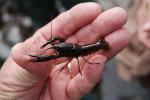
One would think our wet Gulf Coast would be a crayfish paradise. But the Panama City crayfish is struggling to find suitable swimming holes and burrowing land these days with its habitat shrinking.
The majority of their preferred habitat is in the eastern portion of their territory in the Panama City urban core. Yet, there are a few areas in which federal and state wildlife officials say the Panama City crayfish seems to be thriving, so much so, the crayfish are more genetically diverse than others in the city.
One of those areas is on Gulf Power’s transmission easements where the utility’s environmentally friendly management practices create ideal crayfish habitat — wide-open spaces, low vegetation and wetlands, said Michael Sisson, a Florida Fish and Wildlife Conservation Commission biologist. These conditions offer the perfect menu of crayfish food — dead animals, plants and decomposed organic matter, and provide great burrowing ground and plenty of breeding options.
“As wildlife officials consider listing the crayfish as “threatened” under the Endangered Species Act (ESA), they are looking to Gulf Power to donate some of the population of more genetically diverse crayfish and introduce them to the isolated populations to help strengthen the genetic pool throughout the Panama City area,” said Kimberly Blair, Gulf Power spokesperson.
The U.S. Fish and Wildlife Service, which is working hard to keep the crayfish from being listed, is jointly funding the translocation work with the Florida wildlife commission. The commission manages the project.
"Gulf Power's work with us to benefit the crayfish's habitat is a great example of the kinds of partnerships we thrive on in this part of the country," said Sean Blomquist, deputy field supervisor in Panama City for Fish and Wildlife. "We share the same goal to conserve the crayfish and its habitat in an effort to minimize any regulatory necessities."
Gulf Power’s environmental affairs Natural Resource Strategy manager and Environmental Stewardship coordinator are collaborating with the federal and state agencies on the project.
On a recent sweltering summer day, FWC biologist Michael Sisson sloshed through a bog filled with vibrant yellow pitcher plants in the shadows of Gulf Power transmission towers and explained that crayfish on these easements are doing so well, they’re genetically healthier than many of their counterparts isolated in small populations elsewhere in the city.
“Under Gulf Power’s lines and on St. Joe timberland property, the population has good connectivity with a larger population for breeding,” Sisson said. “In the city, they are living in tiny spots and only breeding with the small population in that spot. It is much better to have more genetic diversity in the population.”
One of those spots is a small waterfilled ditch hemmed in by a railroad track and a busy road near U.S. 98. Sisson and other FWC biologists are scouring these isolated spots conducting population surveys and collecting data, to be able to measure the success of the genetics program in the future.
When Sisson waded through the ditch along the railroad track and dipped a net into the dark water and he brought up all sorts of squirming and jumping creatures — black tadpoles, a tiny iridescent-green tree frog, and water spiders and bugs — all trying to escape through the small holes or over the side. Crawling around in the mix were a number of juvenile Panama City crayfish, likely, too closely related.
“As biologist work to strengthen the Panama City crayfish genetic pool, state and federal wildlife agencies are also using Gulf Power’s land management practices as an example to other landowners of how the right kind of vegetation management can help support crayfish populations and turn around their decline,” Blair said.
Jennifer Manis, a biologist in the FWC Panama City office, said it’s getting harder to find “open, grassy areas” outside the transmission easements.
“Historically, fire helped maintain longleaf pines and flatwoods that support the Panama City crayfish and many other fire-dependent species,” she said. “Today, maintaining much of the area’s ecosystem with fire is difficult because of development. In the absence of fire, vegetation has to be managed by hand, the way Gulf Power manages its easements.”
Other major threats outside of the Gulf Power easements, including the restricted range, ditch maintenance, soil disturbance, timbering practices, off-road vehicles, pesticide and herbicide use, and collection for bait, increases the Panama City crayfish species vulnerability to extinction from natural and environmental catastrophes, such as hurricanes.
Some people may scratch their heads and wonder why is this particular crayfish so important?
Brandon Smith, Gulf Power’s Endangered Species Act manager, said they are important in many ways.
“The Panama City crayfish species is not found anywhere else in the world and being listed as “threatened” means they are expected to be extinct in 20-30 years,” Smith said. “They are an important food source for many animals including … bass, bream, otters, raccoons and wading birds. More importantly, it is our responsibility to be good stewards and to protect environmental diversity, no matter how small it may seem.”
####
About Gulf Power
Company. Gulf Power serves more than 460,000 customers in eight counties throughout Northwest Florida. The company’s mission is to safely provide exceptional customer value by delivering reliable, affordable and environmentally responsible electricity while strengthening our communities. Visit online at MyGulfPower.com or on the company’s Facebook, Instagram and Twitter pages. News information can be found at GulfPowerNews.com.
Rick DelaHaya
Media Relations
850-444-3205, cell 318-294-2338
Kimberly Blair
Media Relations
850-444-6050, cell 850-206-5132